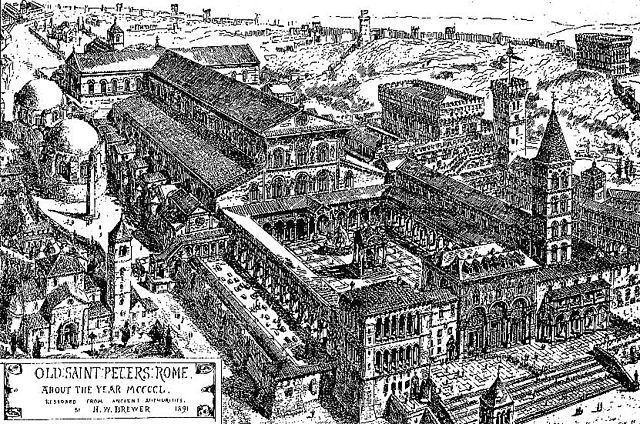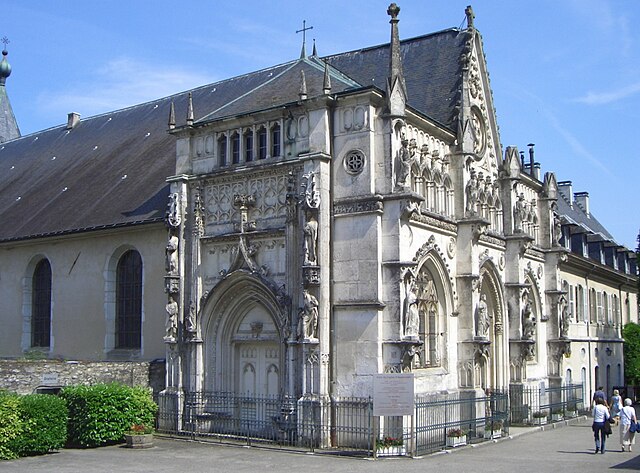| Pontificate |
Common English name |
Sculptor |
Location |
Notes |
|---|
| a217–235 |
Hippolytus
Saint Hippolytus |
Unknown |
Cemetery of Hippolytus |
Remains translated to Rome by his rival Pope Fabian; inscription by Pope Damasus I recorded in Orazio Marucchi's Christian Epigraphy[8] |
| b251–258 |
Novatian |
Unknown |
Unknown |
Tombstone discovered in 1932 on the Via Tiburtina in Rome with the inscription "blessed martyr Novation"; considered unverified by scholars because the inscription lacks the word "bishop"[11] |
| c355–365 |
Felix II
Saint Felix |
Unknown |
Church on Via Aurelia |
Martyred and sainted; buried in a church of his making on the Via Aurelia according to Liber Pontificalis[12] |
| d366–367 |
Ursicinus |
Unknown |
Gaul |
[12] |
| e418–419 |
Eulalius |
Unknown |
Unknown |
Nothing known of death but year[13] |
| f498–499 |
Laurentius |
Unknown |
Unknown |
Died on the farm of his patron Festus[14] |
| g530 |
Dioscorus |
Unknown |
Unknown |
Memory was officially condemned by Pope Boniface II but reinstated by Pope Agapetus I[6] |
| h687 |
Theodore |
Unknown |
Unknown |
Nothing known of him after his concession to Pope Sergius I[15] |
| i687 |
Paschal |
Unknown |
Unknown |
Imprisoned in an unknown monastery until his death and buried in an unknown location[15] |
| j766–768 |
Constantine II |
Unknown |
Unknown |
Died in an unknown monastery after much corporal mortification at the hands of the followers of Pope Stephen III[16] |
| k768 |
Philip |
Unknown |
Unknown |
No historical references after his return to his Monastery of St. Vito (Rome)[16] |
| l844 |
John VIII |
Unknown |
Unknown |
Nothing more known after he was confined to a monastery[17] |
| m855 |
Anastasius |
Unknown |
Unknown |
[18] |
| n903–904 |
Christopher |
Unknown |
Old St. Peter's Basilica |
Interred in Old St. Peter's by his overthrower, Pope Sergius III; destroyed in the seventeenth century demolition of Old St. Peter's; fragment of epitaph recorded by Peter Mallius[9] |
| o984–985 |
Boniface VII |
Unknown |
Unknown |
Roman mob seized his corpse, stripped him of his vestments, dragged him through the streets, and deposited it at the feet of a statue of Marcus Aurelius on horseback, at which point he was trampled and stabbed; carried away by clerics at night and buried in an unknown location[19] |
| p997–998 |
John XVI |
Unknown |
Unknown |
Bodily mutilated by Pope Gregory V and Otto III, Holy Roman Emperor and confined to a Roman monastery until his death[20] |
| q1012 |
Gregory VI |
Unknown |
Hamburg, Germany |
Died in Hamburg; no documentation of funeral or monument exist[21] |
| r1058–1059 |
Benedict X |
Unknown |
Sant'Agnese in Agone |
Sarcophagus in the crypt (not open to public) still contains his corpse[22] |
| s1061–1064 |
Honorius II |
Unknown |
Unknown |
Died in Parma[22] |
| t1080 |
Clement III |
Unknown |
Unknown |
Died in Civita Castellana[23] |
| u1100–1101 |
Theodoric |
Unknown |
Cava de' Tirreni |
Died at La Trinità della Cava but buried in the local cemetery; tombstone contains the words "Theodoric, 1102"[24] |
| v1101 |
Adalbert |
Unknown |
Benedictine Abbey of San Lorenzo (Aversa) |
[24] |
| w1105–1111 |
Sylvester IV |
Unknown |
Unknown |
Died under the care of his patron, Count Werner of Ancona; nothing of death or burial known[24] |
| x1118–1121 |
Gregory VIII |
Unknown |
Unknown |
Imprisoned in many places; last known to have been kept in Cava de' Tirreni, but it is unknown if he died there[24] |
| y1124 |
Celestine II |
Unknown |
Unknown |
Not an antipope sensu stricto, because his election was legitimate; he was forced to resign a papacy a day after and subsequently submitted to the Pope Honorius II, who was elected in his place.[25] Died from beating inflicted during the election.[26] |
| z1130–1138 |
Anacletus II |
Unknown |
Santa Maria in Trastevere |
Destroyed by Pope Innocent II along with much of the church; Innocent II arranged for his own burial, in the rebuilt church, on the site of his former rivals'[2][27] |
| za1138 |
Victor IV |
Unknown |
Unknown
(perhaps priorate of S. Eusebio in Fontanella[28]) |
Nothing known of his biography after his resignation[2] |
| zb1159–1164 |
Victor IV |
Unknown |
Monastery in Lucca |
The clergy of the Lucca Cathedral and San Frediano would not allow him buried there because of his excommunication; tomb destroyed by Pope Gregory VIII in December 1187[1] |
| zc1164–1168 |
Paschal III |
Unknown |
Unknown |
Died in Castel Sant'Angelo[1] |
| zd1168–1178 |
Callixtus III |
Unknown |
Unknown |
Died in Benevento[1] |
| ze1179–1180 |
Innocent III |
Unknown |
La Trinità della Cava (Cava de' Tirreni) |
[1] |
| zf1328–1330 |
Nicholas V |
Unknown |
Avignon |
Died in the Church of the Franciscans, Avignon[29] |
| zg1378–1394 |
Clement VII |
Perrin Morel |
Musée du Petit Palais, Avignon |
Original canopied tomb in the Avignon Cathedral moved on September 8, 1401 to the chapel of the Celestines, and in 1658 to the choir of the church; almost completely destroyed during the French Revolution, only the head of the effigy remains[3] |
| zh1394–1417 |
Benedict XIII |
Unknown |
Castle of Illueca, Spain |
Originally buried in the chapel crypt in Peñíscola; translated to Illueca, Spain and mummified under glass, attracting pilgrims; smashed by an Italian prelate Porro in 1537, after which the room was sealed by the archbishop of Saragossa; destroyed and desecrated by the French during the War of the Spanish Succession; skull recovered and put on display at the castle; buried in the palace of the Counts of Argillo y Morata at Sabinan in 1936 during the Spanish Civil War; skull stolen on August 23, 2000 by the Mayor of Illueca, Javier Vicente Inez, who attempted to ransom it; Spanish police recovered the skull and returned it to the Castle at Illueca on September 3, 2000[4] |
| zi1409–1410 |
Alexander V |
Niccolò di Piero Lamberti and Sperandio Savelli |
San Francesco (Bologna) |
Wall tomb[30] |
| zj1410–1415 |
John XXIII |
Donatello and Michelozzo |
Florence Baptistry |
See Tomb of Antipope John XXIII |
| zk1423–1429 |
Clement VIII |
Unknown |
La Seu (Mallorca) |
Buried in the Cappella de la Piedad in the Cathedral of Palma, Spain[7] |
| zl1424–1429 |
Benedict XIV |
None |
Under a rock in Armagnac, France |
Refused burial in a church because of his excommunication[7] |
| zm1430–1437 |
Benedict XIV |
Unknown |
Unknown |
Died imprisoned in Château de Foix[7] |
| zn1439–1449 |
Felix V
Amadeus VIII, Count of Savoy |
Unknown |
Hautecombe Abbey (Ripaille, France) |
Destroyed during the French Revolution; name listed on an extant memorial plaque that commemorates him and the other Counts of Savoy, whose tombs were also destroyed in the same Abbey[5] |









